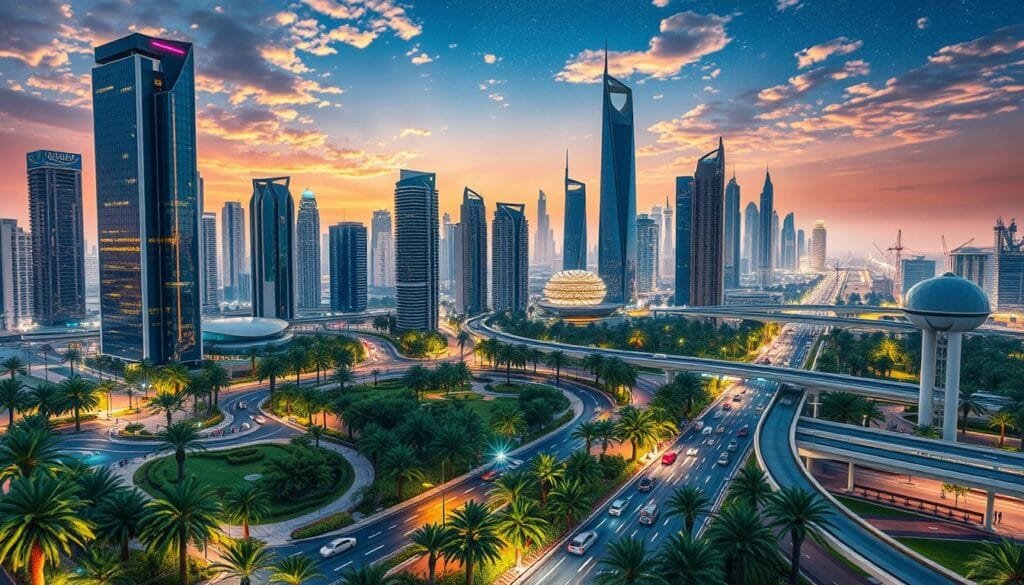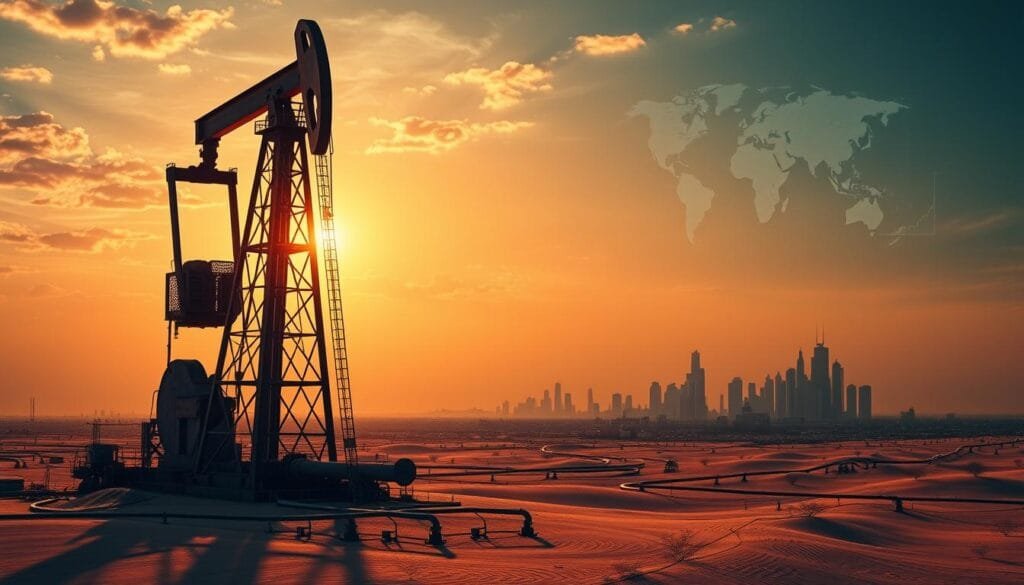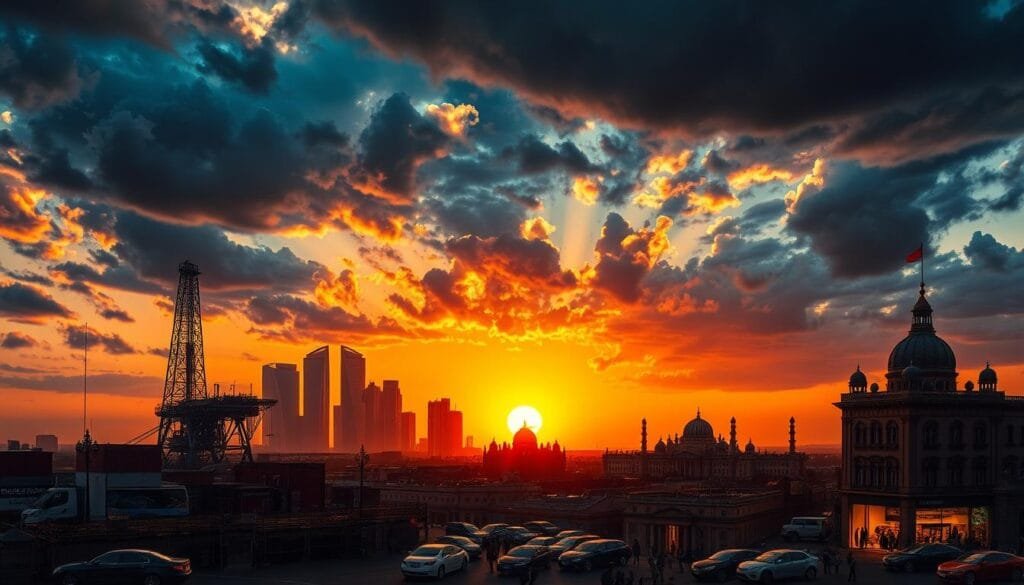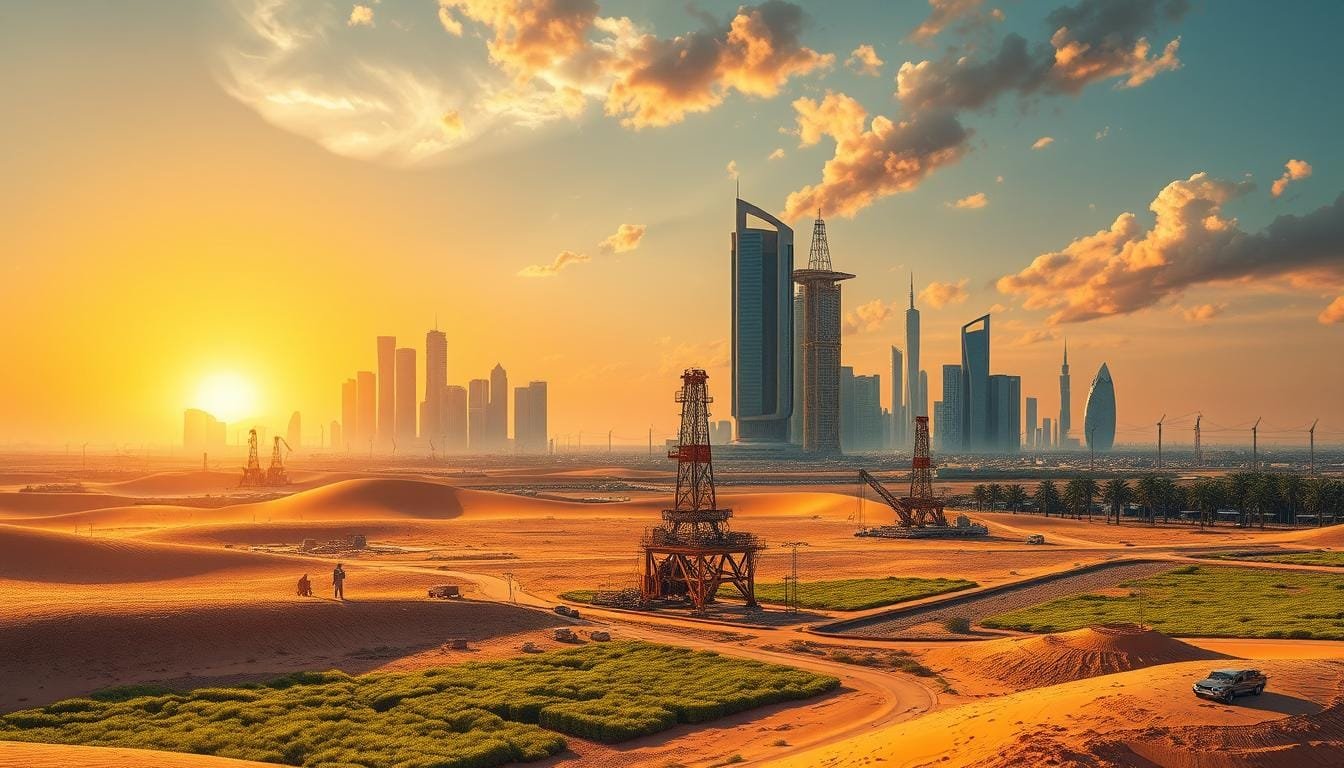Southwest Asia is a place where deserts meet ancient maritime paths. It has grown from a cultural hub to a center of global energy. This change is largely thanks to oil and natural gas. These resources have sparked economic growth in the region.
The area’s wealth in oil plays a big role in its economy. Countries like Saudi Arabia and the United Arab Emirates sit on over half the world’s oil reserves. They use this to compete globally, leading to high oil profits and influence.
But, the story doesn’t end with oil export. These countries are also investing in their people and communities. Places like Israel and Turkey are focusing on education and human development. This makes their economies stronger and more sustainable.
Being rich in oil brings challenges, too. Nations in Southwest Asia that are part of OPEC control oil prices and production. This power affects markets and policies worldwide. Understanding these dynamics is key.
Key Takeaways
- Largely concentrated oil reserves in Southwest Asia command a critical role in the economic growth and development of the region.
- Developed countries’ dependence on oil underscores the strategic importance of Southwest Asia on a global scale.
- The economic powerhouses of the region include nations with significant stakes in the oil market, such as Bahrain, Saudi Arabia, and the United Arab Emirates.
- The formation of OPEC highlights Southwest Asia’s commitment to managing its oil assets collectively and strategically.
- Understanding the intricacies of oil production and distribution is vital for analyzing SW Asia’s influence on international markets and politics.
- Research centered around the world’s oil reserves near the Persian Gulf is essential for grasping global energy systems and their economic ramifications.
- While oil drives development, it also has the potential to spark conflicts, making it a delicate resource that requires prudent management.
The Historical Context of Oil Discovery in Southwest Asia
Southwest Asia has long been a sweet spot for ancient trade routes. These routes shaped earlier civilizations. Later, it became crucial in the oil discovery history. This area, loaded with past events, leads the oil exploitation story. It changed how the world uses energy and the economy.
From Ancient Trade Routes to Oil Riches
Southwest Asia linked major trade paths, affecting ancient trade. Places like Babylon grew due to these routes. They allowed goods to move and laid the foundation for economic changes. Especially changes caused by oil.
The Geological Formation of Oil Reserves
The geological oil formation here took millions of years. It happened due to sediment buildup and organic matter breaking down under pressure and heat. This led to large oil reserves across the Arabian Desert and surrounding areas.
These reserves are under the Earth, blocked by solid cap rocks. This fact makes drilling difficult. Understanding these barriers is key to getting how oil exploitation methods changed over time.
First Discoveries and Initial Exploitation
In the early 1900s, major oil finds changed the region’s future. It sparked economic boom and industrial growth. Southwest Asia went from a trade center to a leading player in the oil world.
The first oil extraction methods were simple. Yet, they started an industry that now shapes global oil markets and economics.
Looking at its growth, it’s clear oil played a big role in Southwest Asia’s development. It changed communities and economies with massive wealth. The oil story here is about more than just geology and trading. It’s a story of human effort and changing the planet.
How has oil impacted the development of sw asia economically/
The economic impact of oil on Southwest Asia is huge. It has dramatically changed the region, boosting national wealth and its global status. Thanks to oil, these countries play a key role in the world’s economy.
The benefits of oil are seen in many ways. It has increased government money and helped build modern cities. Saudi Arabia, Kuwait, and the UAE have used their oil wealth to create cities that compete with the top capitals of the world. Yet, there is a concern about how long this wealth will last.
The oil and gas industry does more than make money. It has improved healthcare and education by funding hospitals and universities. But, there are problems to solve, like finding different ways to make money and reducing harm to the environment.
| Year | Key Economic Indicator | Impact Detail |
|---|---|---|
| 2014-2016 | Oil Price Drop | From $108/barrel to $30/barrel, prompting varied regional economic responses. |
| 2015-2016 | Upstream Investment Reduction | Down by 20%, significantly affecting project continuations and new initiatives. |
| 2017-2023 | OPEC Production Cut | Agreed cut of 1.2 million b/d to stabilize market prices, with Russia’s cooperation reducing an additional 600,000 b/d. |
| Long Term | Strategic Investment Shifts | Increased focus on renewable resources aiming for a minimum of 27% share by the EU by 2030. |
In summary, oil has brought wealth to Southwest Asia, but it also comes with problems. As these countries work towards a more diverse economy and caring for the planet, the lessons from relying on oil will guide their future decisions.
The Transformation of Economies with Oil Wealth
In recent decades, the economies of Southwest Asia have gone through big changes, thanks to oil wealth investments. This money has helped these countries start to build a brighter future with infrastructure developments and urban growth. These steps are moving towards economic diversification, which is key for lasting success after the oil era.

Diversification Beyond the Oil Sector
Realizing the importance of not just relying on oil, countries in Southwest Asia are changing their focus. They’re investing in tourism, financial services, and technology to create a diverse economy. This approach helps reduce the ups and downs of oil markets and builds a strong economy ready for global changes.
Investment in Infrastructure and Urban Development
These countries are taking big steps in infrastructure to meet their economic goals. You can see new airports, highways, and smart cities being built, like in Dubai. Dubai changed from a small trading town to a huge city known worldwide. These projects improve life for people living there and make these cities important for global business and tourism.
| Year | Infrastructure Investments (USD Billion) | Key Projects |
|---|---|---|
| 2015 | 120 | Expansion of Dubai International Airport |
| 2017 | 210 | Development of Neom City in Saudi Arabia |
| 2021 | 350 | Construction of the Doha Metro System |
These countries have a well-thought-out plan with infrastructure developments and urban growth at its core. Their goal is to make economies that are varied and lively, not just based on oil. This smart move towards economic diversification is essential for their ongoing growth.
OPEC and Its Role in SW Asia’s Oil Dominance
The Organization of the Petroleum Exporting Countries (OPEC) plays a big role in the global oil market. Its members, mainly in Southwest Asia, help stabilize oil markets. They make sure there’s a steady flow of oil, which supports the economies of these oil-producing countries.
OPEC’s impact on oil prices and supply is huge. It consists of big oil producers like Saudi Arabia and the UAE. By managing how much oil they produce, OPEC helps regulate supply and prices. This is crucial for the economies of its members and the world.
OPEC continues to play a dominant role in the oil market, accounting for over 70% of global reserves, with Venezuela and Saudi Arabia being the two major contributors.
OPEC’s policies really do affect the market. For example, global oil use went up by 32% from 66 million barrels a day to 88 million between 1991 and 2011. At the same time, oil reserves grew by 60%. This shows how OPEC’s actions impact exploration and development in the oil market.

Recently, new oil sources and technologies have changed the market. OPEC countries have adjusted their output and invested a lot in exploration. In 2012, they spent nearly USD 80 billion on oil and gas exploration. This was a big increase from the past. It shows how OPEC adapts to new challenges and supports its member countries.
In conclusion, OPEC’s role in making Southwest Asia dominant in the oil market is clear. By working together, making strategic decisions, and adapting to new technologies, OPEC remains a key player in the global oil markets. It ensures stability and profits for its member states, influencing the whole oil industry.
Social and Political Impacts of Oil Wealth
The discovery and exportation of oil in Southwest Asia have sparked big changes in society and politics. The social implications of oil wealth have improved living standards in countries like Saudi Arabia, the United Arab Emirates, and Iraq. These nations have huge oil reserves. Yet, this wealth also brought problems, like income inequality and the political influence of oil.
Improvement in Living Standards
Thanks to oil money, investments in healthcare, education, and infrastructure have increased. These changes have greatly improved living conditions. Now, people in oil-rich countries enjoy better services and luxuries than before.
Social Challenges and Income Disparities
However, not everyone has benefited equally from oil wealth. This has caused big gaps in income inequality. The gap is wide between people working in the oil industry and those who don’t. It’s also wide between regions rich in oil and those not.
Oil, Politics, and Power
The huge wealth and political influence of oil link closely to power in Southwest Asia. Oil control is key in politics, affecting relations within countries and with others. It often makes ethnic and religious tensions worse.

Let’s take a detailed look at how oil wealth affects society and governance in the table below:
| Country | Oil Reserves (billion barrels) | Human Development Index (HDI) | Gross National Income (GNI) per capita | Corruption Perception Index |
|---|---|---|---|---|
| Saudi Arabia | 267 | 0.854 | $20,120 | 49 |
| United Arab Emirates | 97.8 | 0.866 | $37,750 | 71 |
| Iraq | 145 | 0.674 | $5,930 | 20 |
| Iran | 208 | 0.783 | $5,420 | 25 |
| Kuwait | 101.5 | 0.806 | $27,260 | 40 |
Countries like the UAE and Saudi Arabia have high HDI and GNI values, showing oil wealth can improve lives. But, the link between oil riches and less corruption isn’t simple. This proves oil wealth doesn’t automatically lead to fair social progress or good governance. It highlights the complex social implications of oil wealth, which can uplift society but also maintain existing problems.
Environmental Challenges and Renewable Energy Initiatives
The 21st century has brought environmental challenges to the forefront. We now must rethink our reliance on traditional energy sources, like oil. As we face climate change effects, the high costs of oil dependency have become clear. This has sparked a crucial move towards renewable energy adoption.
Our use of non-renewable resources has pushed us towards greener energy sources. A report by CSIS discusses initiatives in Southeast Asia. These efforts focus on reducing environmental impacts while promoting economic growth and energy security.
The Environmental Cost of Oil Dependency
The environmental toll of relying on oil is severe. In Southeast Asia, energy demands are growing fast. This rise increases the rate of oil extraction and use. As a result, we see more greenhouse gas emissions, leading to various climate issues in the region.
Shifting Towards Renewable Energy Sources
A positive move towards renewable energy is happening. Countries are now investing in solar, wind, and hydropower. By 2025, renewables are set to reach at least 23% of the ASEAN energy mix. This shift is crucial for lowering our carbon footprint and moving towards sustainability.
| Energy Source | 2016 % | 2023 % (Indonesia) | 2030 Target % (Indonesia) |
|---|---|---|---|
| Coal | N/A | 43% | N/A |
| Oil | N/A | 31% | N/A |
| Natural Gas | N/A | 16% | N/A |
| Renewables (Total) | 26% | 8% | 34% |
| Solar | N/A | Included in renewables | 26% |
| Hydropower | 14% | Included in renewables | 21% |
Moving to renewable energy sources helps us face environmental challenges and reduces oil dependency costs. With help from around the world, ASEAN countries are boosting their use of renewables. This effort keeps us on track for a sustainable energy future.
Conclusion
The future of SW Asia’s oil economy is bright but filled with challenges. The energy revolution in the Middle East has kept these nations at the forefront of global economic change. But, to keep thriving, they must shift from relying mainly on oil to embracing sustainable growth. The 1973 OPEC embargo shows the risks of depending too much on one resource. It led to huge changes in oil prices and caused economic and political troubles.
That crisis taught important lessons, like the need to adapt and find new ways to keep economies strong. Now, with technology improving, SW Asia has a great chance to lead in building a strong and varied economy. Countries like Azerbaijan and Kazakhstan have relied a lot on oil. But now, aiming for resources like solar power can make their economies more stable and diverse.
It’s vital for Middle Eastern countries to find a balance between growth and taking care of the environment. The shift away from oil will not only change their futures but also affect the whole world. Studies by experts like Hamilton and Lee show that oil prices and economic growth are closely linked. So, countries need to think ahead and be ready for change to build strong, lasting economies.
FAQ
What factors contributed to SW Asia’s economic development?
The abundance of oil and natural gas in SW Asia has fueled its economic growth. These resources have been central to evolving economies and infrastructure. They’ve transformed the region significantly.
How did ancient trade routes influence the discovery of oil in SW Asia?
Ancient trade routes made SW Asia a key commercial center. This status aided in finding oil. The region’s strategic location also played a role in the discovery of oil.
What geological processes led to the formation of oil reserves in SW Asia?
Oil reserves in SW Asia formed over millions of years. Marine life remains faced intense heat and pressure. This process transformed them into oil under layers of rock.
How did oil exploitation begin in SW Asia?
The start of oil exploitation in SW Asia came with drilling the first oil fields. This early phase grew into a major industry. It changed the region’s economy and its future.
What are the economic impacts of crude oil development in SW Asia?
Oil has brought wealth and better infrastructure to SW Asia. Nations have seen improved medical care and living standards. But, this success faces challenges because oil won’t last forever.
How has oil wealth led to diversification in SW Asia’s economies?
Oil wealth has pushed SW Asia to diversify its economy. The region is expanding into sectors like tourism and technology. This move aims to reduce reliance on oil.
What has been the role of OPEC in the global oil market?
OPEC, featuring major SW Asian countries, helps control oil policies. It works to stabilize prices, ensure producers get fair returns, and keep oil flowing to consumers.
What social and political challenges has SW Asia faced due to oil wealth?
The oil wealth has improved lives but also led to issues. SW Asia sees income gaps and political power struggles. Sometimes, this tension leads to unrest.
How is SW Asia addressing the environmental cost of its oil dependency?
SW Asia is tackling environmental issues from oil use. The region is turning to renewable energy like solar and wind. This shift aims to cut pollution and oil dependence.
What steps are being taken towards sustainable development in SW Asia?
For sustainable development, SW Asia is embracing renewables and diversifying its economy. These efforts seek a balance between growth and environmental stewardship.
